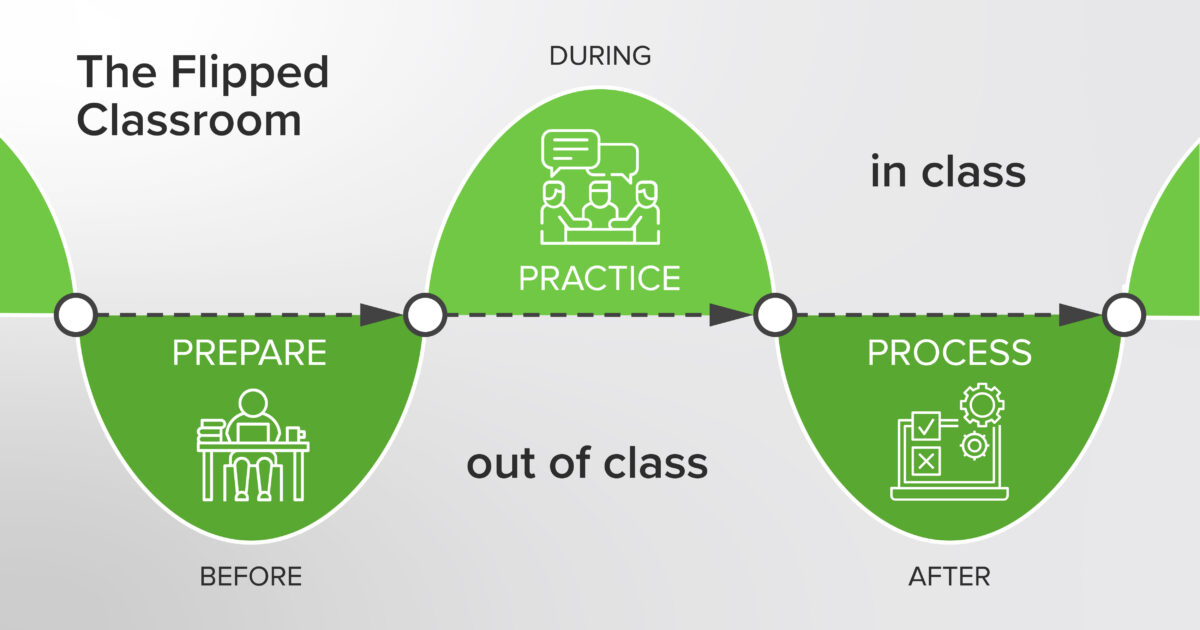What Is a Flipped Classroom Approach?
A flipped classroom is a teaching strategy which falls under the category of blended learning and is focused on student engagement and active learning. In the flipped classroom model, instructors have students interact with new material before in-class learning begins. Instructors can then use in-class time to discuss the new information and put that new knowledge into practice. Its benefits include providing educators with better opportunities to manage mixed levels of student performance, addressing individual or student cohort challenges, and allowing for differentiated learning preferences during in-class time.
Why Implement a Flipped Classroom Approach?
The flipped classroom approach improves educator effectiveness
Today, medical students are able to access information independently and at a pace that faculty cannot match within the time constraints of a single lecture or a traditionally structured course. Medical Students thus need faculty who can:
- Guide them to trusted high-yield key foundational content
- Facilitate self-directed learning of that content
- Actively engage students in application and higher forms of thinking and problem-solving
The flipped classroom model reflects the paradigmatic shift taking place within medical education from educator-centered to student-centered instructional strategies.
Comparison of Teacher-Directed Learning vs. Student-Centered Learning

The flipped classroom approach improves student motivation
When the flipped classroom approach is implemented properly, medical students can perform better due to higher intrinsic motivation. The flipped classroom model turns in-class time into a more individualized experience for medical students. Instead of a lecturer addressing all students as a group, individual learners move at their own pace or in small groups to apply their knowledge in more practical and targeted ways; this allows for a more differentiated experience overall and better-motivated medical students. A flipped classroom approach offers medical students the benefit of greater control over their learning by providing:
- More autonomy while exploring pre-class contents on their own and at their own pace
- Increased relatedness through meaningful, intellectual interactions with peers, instructors, and content in class
- Better development of core competencies thanks to robust assessments and feedback
How to Implement a Flipped Classroom Approach
Step 1: Pre-class content
- Pre-class content delivery is a faculty-driven process of identifying, packaging and providing key foundational content to students prior to class.
- Use various tools and modalities like video lectures, web-based modules, e-books, traditional journal readings, etc.
- Be sure to provide clear learning objectives for each class session so that students know what to focus on.
- Use assessments (prior to class or right at the beginning of class) to hold students accountable for pre-class learning. That helps to ensure that students come prepared. Individual students can complete an Individual Readiness Assurance (IRAT) or a Team Readiness Assurance Test (TRAT). Consider using online educational tools for this assessment.
Step 2: Design in-class activities
- In-class activities should be used to reinforce key learning objectives, contextualize and apply content learned prior to and during class, and assess mastery of concepts.
- Focus on activities that promote higher order thinking and application.
- Balance the time spent on application, concept clarification, and assessment.
- Develop a script.
- Avoid class time to simply “add more content.”
Step 3: Assess student learning
- Use comprehension performance feedback from IRAT and TRAT assessments to continuously calibrate both in-class and out-of-class content.
- Rethink traditional approaches to student learning assessment. Use formative, summative, informal, and formal assessment methods.
- Place emphasis on assessing the students’ ability to analyze, synthesize, and evaluate course concepts.
Using a Platform-Based Flipped Classroom Approach
As an instructional strategy designed to introduce blended learning into medical education, the flipped classroom approach has become increasingly popular in the last few years. While reversing the traditional learning environment by delivering instructional content, often online and outside the classroom, it not only disburdens faculty from explaining basics over and over again, but also moves more complex learning objectives, assessments, and activities into the classroom setting and focuses on the teacher as a coach. A meta-analysis of 26 studies focusing on the effects of flipped classroom utilizing videos versus traditional classroom on medical student learning was conducted in 2018. As a result, an overall significant effect in favor of flipped classrooms using video content over traditional classrooms for medical education was shown (SMD = 0.33, 95%, CI = 0.21–0.46, p < 0.001). This underlines the significant improvement of student learning compared to traditional teaching methods. Lecturio has been found to be an effective tool for implementing a flipped classroom approach, as described by the California University of Science and Medicine Associate Dean of Pre-Clerkship Curriculum and Assessment:
“I have been using Lecturio since July 2018 and the results have so far been very impressive in terms of quality and use. Lecturio was used from the very beginning of the first year and the ease of implementation was important for me for integration with teaching and for user access. It is refreshing to see a high quality product like Lecturio that addresses teaching approaches used in medical school teaching and also understands the fundamental professional assessment goals that drive today’s medical student. This is a teaching resource that contributes significantly to how medical educators train learners in the health sciences.”
– Prof. Rajuno Ettarh, Associate Dean of Pre-Clerkship Curriculum and Assessment, California University of Science and Medicine
Lecturio addresses the increased need of medical students to access high quality digital educational materials in order to prepare for and follow-up on classroom teaching during and outside regular teaching hours. A study by the Weill Cornell College of Medicine and Harvard Medical School points out that the most commonly encountered barrier to the use of electronic resources is a misalignment of resources with the school’s curriculum. Thus Lecturio offers individual curriculum mapping to a medical school’s curriculum, which has further proven a worthwhile time investment and is offered to all institutional clients.
Implementing a Flipped Classroom Approach with Lecturio

Implications for remedial learning
Remedial learning is assigned to assist students in order to achieve expected competencies in core academic skills. Blended learning, and specifically the flipped classroom approach can facilitate remedial learning for both individual medical students and struggling cohorts. The potential of digital remediation initiatives with Lecturio can be realized by selectively assigning struggling students additional content to learn and implementing IRAT or TRAT assessments.
In-Depth Expert Discussion [Online Seminar]
This seminar addresses ways to implement a flipped classroom, with a particular focus on new advantages which have emerged while teaching remotely. In keeping with our evidence-based approach to learning and teaching, the seminar focuses on active student-centered learning as is optimally conducted in a flipped classroom environment.
Learning objectives from this seminar include:
- Describing the scientific basis which supports a flipped classroom approach
- Explaining the advantages of using platforms to implement a flipped classroom approach
- Recognizing the specific challenges and proposed solutions to implementing a flipped classroom in an online-based environment
Watch the full seminar recording:
Would you like to learn more? Explore the Pulse Seminar Library.

